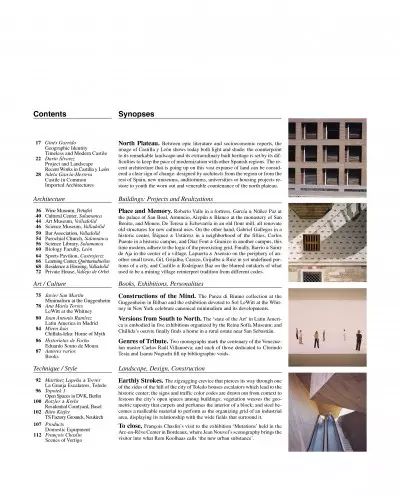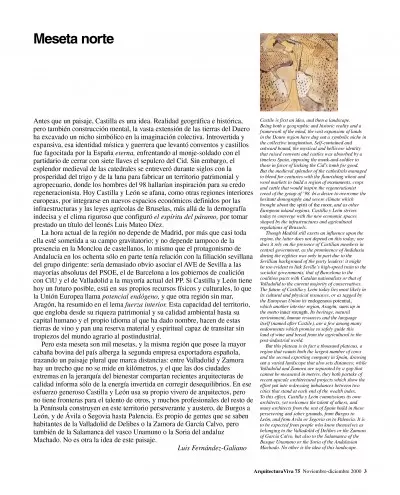Contents
North Plateau. Between epic literature and socioeconomic reports, the image of Castilla y León shows today both light and shade: the counterpoint to its remarkable landscape and its extraordinary built heritage is set by its difficulties to keep the pace of modernization with other Spanish regions. The recent architecture that is going up on this vast expanse of land can be considered a clear sign of change: designed by architects from the region or from the rest of Spain, new museums, auditoriums, universities or housing projects restore to youth the worn out and venerable countenance of the north plateau.
Synopses
Ginés Garrido
Geographic Identity
Timeless and Modern Castile
Darío Álvarez
Project and Landscape
Recent Works in Castilla y León
Adela García-Herrera
Castile in Common
Imported Architectures
Buildings: Projects and Realizations
Place and Memory. Roberto Valle in a fortress, García & Núñez Paz at the palace of San Boal, Arnuncio, Aizpún & Blanco at the monastery of San Benito, and Moneo, De Teresa & Echevarría in an old flour mill, all renovate old structures for new cultural uses. On the other hand, Gabriel Gallegos in a historic center, Íñiguez & Ustárroz in a neighborhood of the fifties, Carlos Puente in a historic campus, and Díaz Font & Granizo in another campus, this time modern, adhere to the logic of the preexisting grid. Finally, Barrio & Sainz de Aja in the center of a village, Lapuerta & Asensio on the periphery of another small town, Gil, Grijalba, Carazo, Grijalba & Ruiz in yet undefined portions of a city, and Castillo & Rodríguez Baz on the blurred outskirts of what used to be a mining village reinterpret tradition from different codes.
Architecture
Wine Museum, Peñafiel
Cultural Center, Salamanca
Art Museum, Valladolid
Science Museum, Valladolid
Bar Association, Valladolid
Parochial Church, Salamanca
Science Library, Salamanca
Biology Faculty, León
Sports Pavilion, Castrojeriz
Learning Center, Quintanadueñas
Residence & Housing, Valladolid
Private House, Vallejo de Orbó
Books, Exhibitions, Personalities
Constructions of the Mind. The Panza di Biumo collection at the Guggenheim in Bilbao and the exhibition devoted to Sol LeWitt at the Whitney in New York celebrate canonical minimalism and its developments. Art / Culture
Javier San Martín
Minimalism at the Guggenheim
Ana María Torres
LeWitt at the Whithney
Versions from South to North. The ‘state of the Art’ in Latin America is embodied in five exhibitions organized by the Reina Sofía Museum; and Chillida’s oeuvre finally finds a home in a rural estate near San Sebastián. Juan Antonio Ramírez
Latin America in Madrid
Miren Jaio
Chillida-leku: Home of Mith
Genres of Tribute. Two monographs mark the centenary of the Venezuelan master Carlos Raúl Villanueva; and each of those dedicated to Clorindo Testa and Isamu Noguchi fill up bibliographic voids.
Focho’s Cartoon
Eduardo Souto de Moura
Various Authors
Books
Interiors, Design, Construction
Earthly Strokes. The zigzagging crevice that pierces its way through one of the sides of the hill of the city of Toledo houses escalators which lead to the historic center; the signs and traffic color codes are drawn out from context to festoon the city’s open spaces among buildings; vegetation weaves the geometric tapestry that carpets and perfumes the interior of a block; and steel becomes a malleable material to perform as the organizing grid of an industrial area, displaying its relationship with the wide fields that surround it. Technique / Style
Martínez Lapeña y Torres
La Granja Escalators, Toledo
Topotek
Open Spaces in DVK, Berlin
Rotzler y Krebs
Residential Courtyard, Basel
Büro Kiefer
TS Factory Grounds, NeukirchTo close, François Chaslin’s visit to the exhibition ‘Mutations’ held in the Arc-en-Rêve Center in Bordeaux, where Jean Nouvel’s scenography brings the visitor into what Rem Koolhaas calls ‘the new urban substance’. Products
Domestic Equipment
François Chaslin
Scenes of Vertigo
Luis Fernández-Galiano
North Plateau
Castile is first an idea, and then a landscape. Being both a geographic and historic reality and a framework of the mind, the vast expansion of lands in the Douro region have dug out a symbolic niche in the collective imagination. Self-contained and outward bound, the mystical and bellicose identity that raised convents and castles was absorbed by a timeless Spain, opposing the monk-and-soldier to those in favor of locking the Cid’s tomb for good. But the medieval splendor of the cathedrals managed to blend for centuries with the flourishing wheat and wool markets to build a region of monuments, crops and cattle that would inspire the regenerationist creed of the group of ’98. In a desire to overcome the hesitant demography and severe climate which brought about the spirit of the moor, and as other European inland regions, Castilla y León strives today to converge with the new economic spaces shaped by the infrastructures and agricultural regulations of Brussels.
Though Madrid still exerts an influence upon the region, the latter does not depend on this today; nor does it rely on the presence of Castilian members in central government, as the prominence of Andalusia during the eighties was only in part due to the Sevillian background of the party leaders: it might be too evident to link Seville’s high-speed train to the socialist governments, that of Barcelona to the coalition pacts with Catalan nationalists or that of Valladolid to the current majority of conservatives. The future of Castilla y León today lies most likely in its cultural and physical resources, or as tagged by the European Union its endogenous potential, which another interior region, Aragón, sums up in the motto inner strength. Its heritage, natural environment, human resources and the language itself (named after Castile), are a few among many endowments which promise to safely guide this land of wine and bread from the agricultural to the post-industrial world.
But this plateau is in fact a thousand plateaus, a region that vaunts both the largest number of cows and the second exporting company in Spain, drawing out a varied landscape that also sets distances: while Valladolid and Zamora are separated by a gap that cannot be measured in meters, they both partake of recent upscale architectural projects which show the effort put into redressing imbalances between two cities that stand at each end of the wealth index. To this effect, Castilla y León commissions its own architects, yet welcomes the talent of others, and many architects from the rest of Spain build in these persevering and sober grounds, from Burgos to León, and from Ávila or Segovia on to Palencia. It is to be expected from people who know themselves as belonging to the Valladolid of Delibes or the Zamora of García Calvo, but also to the Salamanca of the Basque Unamuno or the Soria of the Andalusian Machado. No other is the idea of this landscape.








